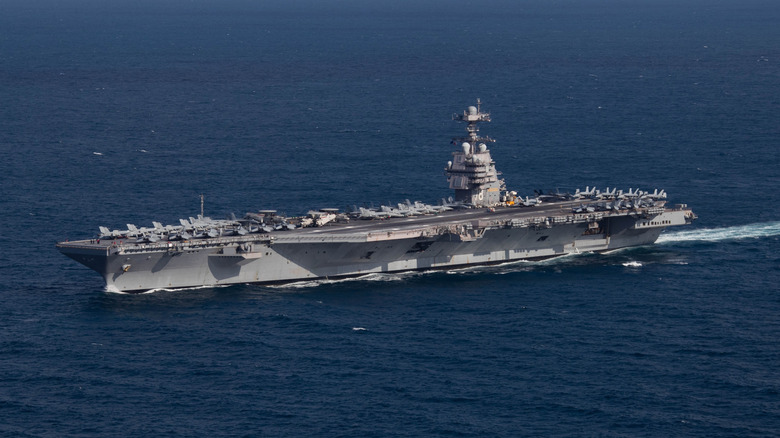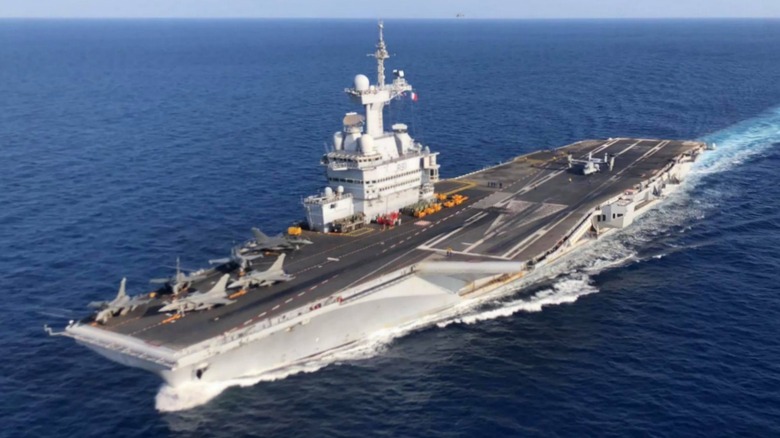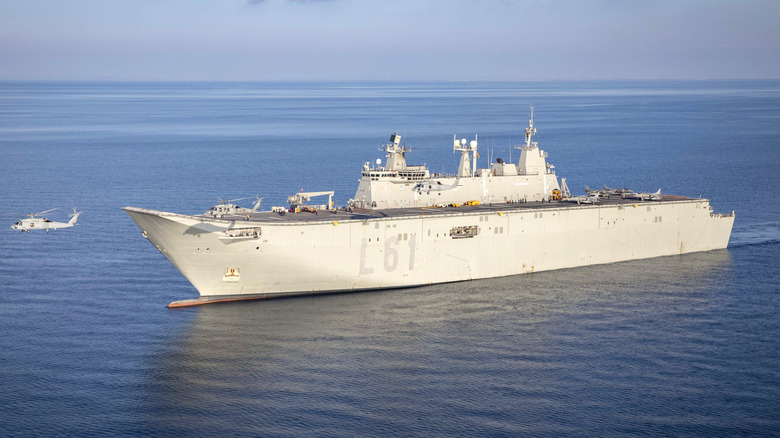How America's Advanced Aircraft Carriers Compare To The Rest Of NATO's Fleet
Depending on how you classify aircraft carriers, there are five NATO countries with aircraft carriers in their navies. The U.S. has by far the most aircraft carriers, with a current fleet of 11 "true" aircraft carriers. Next on the list is the U.K., which can put two carriers to sea. Then there's France, the only country outside the U.S. that can field a nuclear-powered aircraft carrier. After this, things are not quite so straightforward. While Italy, Spain, and Turkey technically have aircraft carriers, some can also be classified as amphibious assault ships. However, for the sake of this article and since they are capable of operating fixed-wing aircraft, including the F-35B, we will treat them as carriers.
Technically, there are distinct differences between the fleets. For instance, the newest American carrier — the USS Gerald R. Ford — displaces about 100,000 tons and can boast an air wing bigger than some entire air forces. Additionally, nuclear power gives these ships virtually unlimited range, allowing them to operate anywhere on the globe without constantly needing to refuel (although it does take an astonishing amount of time to refuel a nuclear-powered aircraft carrier). No other NATO carriers can match these capabilities. To begin with, let's take a look at how American aircraft carriers compare to those of the U.K. and France, the two nations whose carriers come closest to matching the U.S. in terms of capability and global reach.
U.S. Carriers compared against the U.K. and France
We'll start by comparing the only other nuclear-powered aircraft carrier with the American carriers. On the face of it, the nuclear-powered, French carrier, the Charles de Gaulle (CDG), could be on a par with the American fleet in propulsion terms at least. However, even when comparing it to older Nimitz-class carriers, the differences are apparent. The twin reactors on the American ships provide 1100 megawatts of energy and need refueling every five decades or so. The CDG's reactors produce 300 megawatts and require refueling every seven years.
The two British carriers — HMS Queen Elizabeth and HMS Prince of Wales — are powered by two Rolls-Royce gas turbine alternators and diesel generators, giving them a 10,000 nautical miles range. They're also the largest ships ever commissioned by the Royal Navy. However, their displacement of 65,000 tons and the CDG's displacement of 42,500 tons make these ships substantially smaller than the latest 100,000-ton "Ford" class American carriers.
The size differential gives the U.S. carriers a distinct advantage in terms of the firepower they can deploy, with the Gerald R. Ford capable of carrying 90 aircraft. The British carriers can carry 72 aircraft (including a maximum of 36 F-35Bs), while the CDG is limited to 40 aircraft. In terms of speed, the Gerald R. Ford is also top of the class with 30 knots, a close second is the CDG with a credible 27 knots, with the British carriers capable of 25 knots.
How the other NATO countries fare
Comparing "Ford" class carriers against others can seem like a David and Goliath scenario. However, that doesn't detract from the fact that all the ships mentioned remain fearsome weapon platforms. For instance, while the Italian carrier — ITS Cavour — weighs a comparatively measly 30,000 tons, she is still capable of carrying up to 20 F-35B Lightning II jets, and has an impressive top speed of over 28 knots. She can also act as an amphibious landing ship, a hospital ship, and a logistics platform.
The story is similar when we look at Spain's SPS Juan Carlos I. This is a 26,000-ton ship that can carry up to 30 aircraft, including the F-35B and the AV-8B Harrier II. The Juan Carlos is also the slowest carrier we've looked at so far, with a top speed of 21 knots. Finally, we come to the Turkish carrier, the 27,000-ton TCG Anadolu. The design of this ship was based on the Spanish Juan Carlos I carrier and is capable of carrying F-35B jets. However, Turkey was dropped from the F-35B program, and the ship has been largely repurposed to become the world's first carrier/amphibious ship with its airpower almost entirely consisting of drones. Additionally, Turkey is also in the process of building a 60,000-ton "full carrier" that is expected to be launched in 2027 or 2028 and can carry up to 60 aircraft. While NATO's carrier fleet is formidable, the fact remains that American carriers are in a league of their own.


